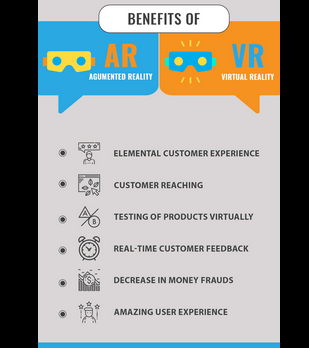Augmented Reality (AR) and Virtual Reality (VR) play significant roles in enhancing the consumer experience across various industries. Both technologies offer immersive and interactive experiences that can elevate engagement, increase brand loyalty, and provide unique opportunities for businesses. The purpose of this study is to highlight the role of AR and VR in enhancing consumer experience:

Augmented Reality (AR):
In-Store Retail Experience:
AR can be used in retail to enable customers to visualize products in their real-world environment before making a purchase. This helps in reducing uncertainty and increasing confidence in buying decisions.
Virtual Try-Ons:
AR enables virtual try-on experiences for products like clothing, accessories, and cosmetics. Customers can use AR apps to see how products look on themselves in real-time, enhancing the online shopping experience.
Product Information Overlay:
AR can provide additional product information when users point their mobile devices at items or packaging. This interactive element adds depth to the shopping experience by delivering multimedia content, reviews, or promotions.
Interactive Marketing Campaigns:
Brands can create interactive and engaging marketing campaigns using AR. AR apps can bring print materials to life, deliver immersive storytelling, or allow users to interact with branded content in real-time.
Navigation and Wayfinding:
AR navigation apps assist consumers in finding their way in physical spaces. This is particularly useful in large stores, malls, or event venues, providing a seamless and enriched navigation experience.
Enhanced Packaging:
Brands can use AR to enhance product packaging. Scanning the packaging with a mobile device can unlock additional content, such as videos, tutorials, or 3D animations, creating a more engaging unboxing experience.
Interactive Print Media:
AR technology can turn static print materials, such as magazines or catalogs, into interactive experiences. Consumers can use their mobile devices to access additional information, videos, or product details.
Virtual Reality (VR):
Immersive Shopping Environments:
VR can create virtual shopping environments where users can explore and interact with products in a 3D space. This is particularly relevant for e-commerce platforms and can simulate the feel of a physical store.
Virtual Showrooms:
Brands can use VR to create virtual showrooms, allowing customers to browse and experience products as if they were physically present. This is beneficial for showcasing large or complex items.
Virtual Product Demonstrations:
VR enables immersive product demonstrations, allowing consumers to experience the features and benefits of products in a virtual setting. This is common in industries like automotive, real estate, and consumer electronics.
Virtual Events and Experiences:
Brands can host virtual events, product launches, or experiences using VR technology. This extends the reach of events to a global audience and offers an immersive experience without physical attendance.
Training and Education:
VR can be used for consumer education and training. For example, brands can provide virtual tutorials on product usage, assembly, or maintenance, enhancing the post-purchase experience.
Gaming and Entertainment:
VR offers immersive gaming and entertainment experiences. Brands can leverage VR to create branded games or content, fostering engagement and interaction with their target audience.
Virtual Travel and Exploration:
In industries like tourism, VR can provide consumers with virtual travel experiences, allowing them to explore destinations before making travel decisions.
Both AR and VR have the potential to transform the way consumers interact with products and brands, providing more personalized, interactive, and memorable experiences. As these technologies continue to evolve, businesses will find new and innovative ways to leverage them to enhance consumer engagement and satisfaction.
